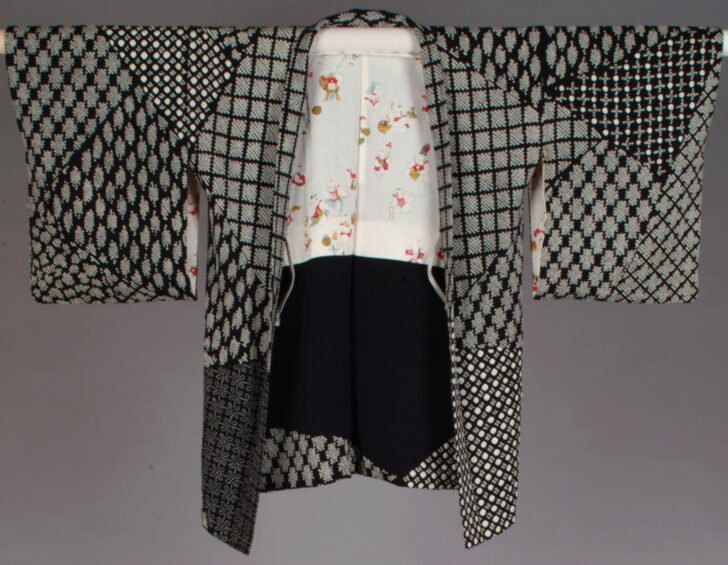Dark indigo Shibori haori with lining depicting children at play
Japanese

Description
Haori
Japan, Showa period (1926–1989)
1960s–80s
White silk with dark indigo shibori (tie-dye) design
Gift of Howard and Patricia Yamaguchi, 2005/1.348
In the shibori technique tiny pinches of fabric are twisted up and tightly bound with thread before the whole piece of cloth is dyed. After dyeing, the binds are undone, leaving tiny dye-reserved rings of white around spots of color. Among the multiple methods of shibori dyeing and the infinite numbers of patterns that these produce, the most common is kanoko shibori (meaning “fawn dapple,” a poetic reference to the dots on a fawn’s back). This painstaking technique was in vogue among the rich merchant class in Edo (modern-day Tokyo) in the aesthetically heightened era of Genroku (the end of 17th century). The all-over dapple type, called sô shibori, in which the entire kimono is covered with tiny dapples, was considered so outrageously luxurious that it was banned by the sumptuary laws of 1686. In this chic, indigo-colored haori, the dapples are of many sizes and form different designs. Ironically, the patterns, which took hundreds of hours to create, resemble a farmer’s patched clothes.
Iwata Shizuko and her sisters owned numerous shibori kimono and haori. Most of these garments are in the all-over dapple style (sô shibori), which is the most labor-intensive to produce and thus regarded as the most luxurious. Nevertheless, in the language of modern kimono, the all-over dapple kimono is, like woven kimono, casual wear, even though it might be as expensive as a hand-painted yûzen kimono. Therefore it would never be worn for the most formal occasions, such as weddings and funerals. If combined with a formal-type obi, however, an all-over dapple kimono would be appropriate for parties and award ceremonies. The Iwata sisters, for example, wore all-over dapple kimono with brocade obi for construction ceremonies, as seen in this photo.
During the late Edo period (1615–1868), women wore overcoats modeled loosely on those of men for rainy and colder weather; the man’s overcoat, in turn, had been adapted from the Western cape worn by the Jesuit missionaries who came from Portugal to Japan in the sixteenth century. In the Taisho period (1911–1925), more elegant michiyuki (meaning “strolling on the street”) and longer dôchûgi (meaning “strolling on the road”) coats became popular. Michiyuki and dôchûgi are worn strictly as outerwear; unlike haori, which also may be worn indoors, they need to be removed and folded upon entering a building. Made of durable fabrics, such as polyester and heavy wool, they function to protect delicate silk kimono and obi from moisture and dust.
Though most michiyuki are made for cold weather, the Yamaguchi Collection contains an exceptional silk gauze michiyuki with green, blue, and purple dyed clouds. This michiyuki, with its loosely woven fabric and cool colors, was intended for summer use. The inner kimono would have shown through the almost translucent michiyuki, enhancing the sensuousness of this light summer garment.
In these exuberant kimono, renowned textile designer Minagawa Gekka took great advantage of the wide, flat surface of the kimono, effectively treating it as a canvas on which to depict flowers blooming in profusion. The early spring flowers of the pink-orange kimono, as well as the blazing orchid and bird-of-paradise on the purple kimono, create vibrant sensory perceptions.
The two identical, pink-orange kimono are from a set of five created by Gekka for Iwata Shizuka, who often commissioned such sets for her daughters. All three of these kimono were made in 1948, just a few years after the end of World War II, which brought catastrophic damage to the nation of Japan and its people. Even so they are made from the highest quality materials and possess an optimistic elegance. Indeed, after the war the Iwata family quickly rebuilt their business in Tokyo, where most of the center was burned down and construction services were in high demand.
(Wrapped in Silk & Gold Exhibition, Summer 2010)
Subject Matter:
This haori required a labor intensive technique called shibori, in which hundreds of hours would have been spent tying up each small section where white can be seen on the fabric before immersing it in dye. Shibori textiles are very expensive due to the time and skill required to produce them.
Physical Description:
This haori demponstrates a variety of geometric patterns of repeating white shapes against a dark indigo ground. It also has an inner silk lining.
Usage Rights:
If you are interested in using an image for a publication, please visit https://umma.umich.edu/request-image/ for more information and to fill out the online Image Rights and Reproductions Request Form.